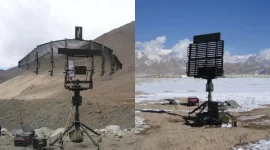- Views: 291
- Replies: 32
The Indian Air Force's (IAF) Su-30MKI fighter jets are set for a significant capability enhancement with the integration of the advanced Virupaksha radar.
This indigenous Gallium Nitride (GaN) based Active Electronically Scanned Array (AESA) radar is specifically engineered to detect and track stealth aircraft from considerable distances.
This upgrade will position the Su-30MKI as India's first 4.5-generation fighter optimised for countering low-observable aircraft, bolstering its effectiveness in contemporary aerial combat scenarios increasingly defined by stealth technology.
Developed by the Defence Research and Development Organisation’s (DRDO) Electronics and Radar Development Establishment (LRDE), the Virupaksha radar marks a substantial improvement over the Su-30MKI's current N011M Bars passive electronically scanned array (PESA) radar.
The Virupaksha features an antenna diameter of 950 mm and is equipped with approximately 2,500 GaN-based Transmit/Receive Modules (TRMs). This configuration delivers superior performance in detection range, target resolution, and resilience against electronic jamming.
GaN technology itself offers greater power efficiency, improved heat management, and enhanced reliability compared to older Gallium Arsenide (GaAs) systems, contributing to a more compact, lighter, and powerful radar system.
The Virupaksha radar system demonstrates impressive detection capabilities, reportedly able to identify a target with a 1m² radar cross-section (RCS) from as far as 600 kilometres.
Crucially, for highly stealthy aircraft with a very small RCS of 0.01m², the radar is estimated to achieve detection at around 200 kilometres. This range effectively brings stealth aircraft into the engagement zone of Beyond Visual Range (BVR) missiles, transforming Su-30MKIs equipped with Virupaksha into formidable hunters of stealth jets.
A primary design focus of the Virupaksha radar is its capacity to detect low-observable aircraft, such as China's J-20 fighter or the J-35A, which could potentially be operated by the Pakistan Air Force.
Stealth aircraft are characterized by an RCS as low as 0.01 m², making them challenging for conventional radars to identify. The Virupaksha’s GaN-AESA technology, along with its high number of TRMs, significantly boosts its sensitivity to these low-RCS targets, allowing for detection at strategically important distances.
The use of GaN semiconductors in the Virupaksha radar also leads to higher resolution imagery, reduced electricity consumption, and better thermal efficiency when compared to earlier AESA systems.
Optimised for tracking multiple targets simultaneously, resisting enemy electronic warfare efforts, and engaging in long-range air-to-air combat, the Virupaksha system will substantially improve the situational awareness and combat effectiveness of the Su-30MKI fleet.
When paired with the upcoming Astra MkIII missile, which boasts a range of 300–350 kilometres, the Su-30MKI equipped with the Virupaksha radar could become the first non-stealth aircraft specifically optimised to engage stealth aircraft from BVR distances.
The combination of the radar's extended detection capabilities and the long reach of the Astra MkIII missile system offers a credible counter to advanced low-RCS threats like the J-35A.
This modernisation is part of the broader "Super-30" upgrade programme, an initiative valued at approximately ₹65,000 crore (around $7.8 billion USD). The programme aims to upgrade 84 of the IAF's 260 Su-30MKI aircraft, with work scheduled to commence in 2026.
Beyond the Virupaksha radar, the upgrade package includes a new digital cockpit, advanced infrared search and track (IRST) systems, and indigenous weapons like the Astra MkIII (also known as Gandiva) missile.
These enhancements will collectively elevate the Su-30MKI to a 4.5+ generation combat platform. The Astra MkIII, featuring solid fuel ducted ramjet propulsion, is designed to complement the radar's long-range detection, creating a highly effective BVR combat solution.
Furthermore, the Virupaksha radar incorporates a swashplate mechanism, enhancing its field of regard. This allows the upgraded Su-30MKI to function akin to a "mini-AWACS" (Airborne Warning and Control System), providing extended surveillance and targeting information.
This capability positions the aircraft to effectively counter regional air threats, notably from platforms like China’s J-20 and Pakistan’s potential J-35A, by detecting and engaging them before their stealth features can be fully exploited.
An IAF official highlighted that the Virupaksha and Astra MkIII combination could act as a significant deterrent, as the radar's X-band frequency's ability to penetrate some stealth characteristics and track low-RCS targets diminishes the operational advantages of opposing stealth aircraft.
In the competitive landscape, Data Patterns unveiled its Hawk I 2700 at Aero India 2025. This is another GaN-based AESA radar featuring 2,700 TRMs, with the company claiming a detection range of 350 km for a 5 m² RCS target and 200 km for a 1 m² RCS target.
While the Hawk I 2700 has a slightly higher TRM count, the Virupaksha radar benefits from a "plug and play" design. This allows for more straightforward integration into the Su-30MKI’s existing nose cone and systems, offering an advantage in terms of retrofit efficiency.
The IAF is currently evaluating both radar systems. The Virupaksha radar is supported by DRDO’s established development and production partnerships with Hindustan Aeronautics Limited (HAL) and Bharat Electronics Limited (BEL).



